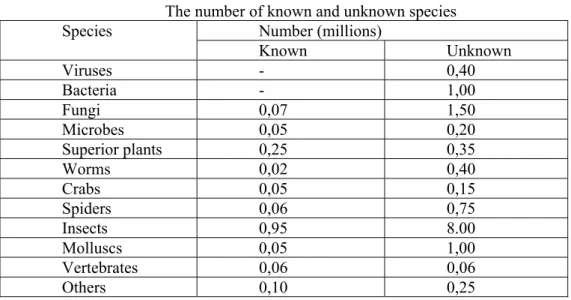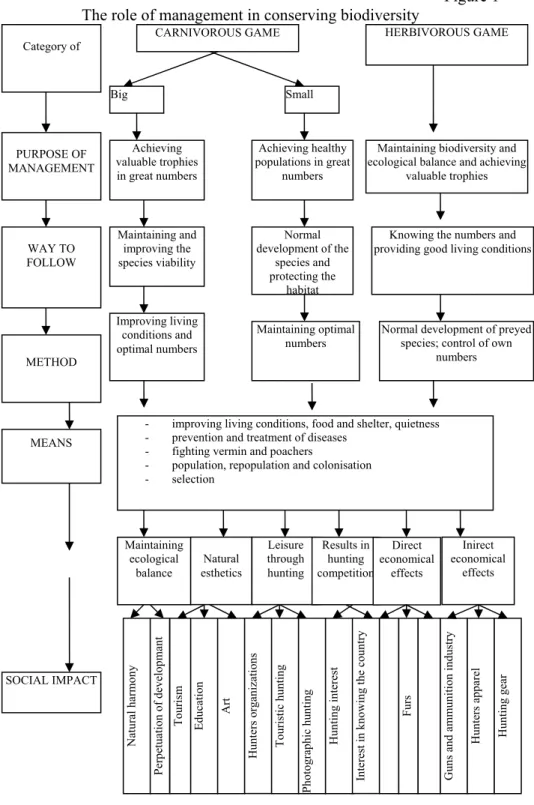Lucrări ştiinţifice Zootehnie şi Biotehnologii, vol. 42(1) ((2009), Timişoara
THE ROLE OF HUNTING TOURISM MANAGEMENT IN
THE CONSERVATION OF BIODIVERSITY
ROLUL MANAGEMENTULUI TURISMULUI CINEGETIC ÎN
CONSERVAREA BIODIVERSIT
ĂŢ
II
I. PETROMAN1, IOANA BĂLAN1, A. MATIUŢI1, EMILIA BĂLA1
1Faculty of Farm Management, Timişoara, România
Although hunting tourism is not a new activity, it appears since the dawn of human evolution, today it must be managed in a professional way in order to protect and keep the environment and the hunted. The development of agriculture and animal breeding has released most of the human communities from the worries of feeding themselves, decreasing considerably the pressure on hunted species as a food resource. In order to practice this type of tourism, some hunted species must be bred in semi wilderness to be used as trophies and food resources and to protect the wildlife. Special emphasis must be put on the productive function of the forest ecosystem, the development and intensification of agriculture, development of the infrastructure, development of mass tourism in protected areas and enlarging the natural habitat of the hunted species, reducing hunting and intensifying observation and study of wildlife behaviour through hunting tourism with an ecological character.
Keywords: tourism, hunting, fauna, habitat, ecosystem, management, biodiversity
Introduction
The problem of biological diversity is heavily debated in the media and discussed at various levels in specific communities and is the centre of attention for many research institutes, national and international organisations, NGOs.
Biological diversity or biodiversity defines the variety of the living world, and the Rio de Janeiro convention defines it as „the variability between living organisms from all sources, including inter alia, ecosystems and terrestrial, marine and other aquatic ecological complexes these including the diversity within a species, between species and ecosystems”.(Bulgărescu, 2004; Goicea, 2008)
Table 1 The number of known and unknown species
Species Number (millions)
Known Unknown
Viruses - 0,40
Bacteria - 1,00
Fungi 0,07 1,50
Microbes 0,05 0,20
Superior plants 0,25 0,35
Worms 0,02 0,40 Crabs 0,05 0,15
Spiders 0,06 0,75
Insects 0,95 8.00
Molluscs 0,05 1,00
Vertebrates 0,06 0,06
Others 0,10 0,25
Biodiversity is attributed with many organisation levels: genetic diversity, species diversity, taxonomic diversity, community diversity, landscape diversity, structural diversity, functional diversity and temporal diversity.
The intervention of hunters through hunting tourism would not be beneficial for many of the hunted species; therefore it is imperative that through a professional management they become protectors instead of adversary of the hunted species, keeping the ecological balance, acting for the safekeeping and improvement of the species’ habitat. This is necessary because from the terrestrial fauna 75 species of birds and 27 species of mammals have disappeared during the nineteenth century and the list grows with 53 species of birds, 68 species of mammals and 83 species of reptiles and batrachians. Still, paradoxically, out of the total disappeared or endangered species relatively few can be attributed to hunting, like the buffalo, many disappearing due to deterioration or irreversible change of their environment due to human activities. (Bulgărescu, 2004; Durantel, 1993)
Materials and Methods
Results and Discussion
Under the action of human factors, the forest ecosystem is subjected to intense, unprecedented pressure, an unquantifiable phenomenon, and the intensification of hunting tourism will bring many hunted species to endangerment or even at the brink of extinction.
Out of human activities that disturb the forest ecosystem’s equilibrium, the following must be highlighted:
- The exploitation of mature trees and of the wooden mass destroyed by natural calamities is a great inconvenience for the hunted species, partially destroying the grasses and bushes that make out the spontaneous vegetation and food for herbivorous game that is the prey of the carnivorous game.
- Excessive grazing by domesticated animals (sheep, cows) inside the
forest habitat damages the flora and the habitat reducing the food for the herbivorous game and disturbing the raising of the cubs;
- Practicing hunting tourism excessively disturbs the game and human
activities push the game further away to remote areas which may lack food and shelter.
Alpine and sub alpine ecosystems have been negatively influenced by human activities and by various forms of tourism. Many dense forests have been cut to make way for alpine pastures and therefore some vertebrates adapted to this ecosystem have disappeared due to the lack of optimal conditions for birth and raising the cubs of the black goat, for example. Another negative influence was the building of sheep and cattle farms guarded by dogs that are set free, but also the appearance of mining activities. These human activities have reduced some species habitat and by referring to biodiversity in general, the pollution of creeks and valleys has destroyed any form of life.
The practice of hunting tourism in the sub alpine ecosystem alongside the exaggerated exploitation of forest fruit depleted the resources of food that several species of birds and mammals depend on, such as the grouse and the birch grouse.
Ecosystems such as de veldt, forest veldt and meadow are today much poorer in species compared to forest ecosystems. By human intervention these ecosystems have been transformed through intensive agriculture and uncontrolled hunting tourism, in some areas that have no fauna endemic species of plants, mammals and birds. The best example is the extinction of the great bustard from Bărăgan and Banat, as a result of the transformation of the quiet nesting and feeding in farmland, mechanised intervention, the disturbed peace but also poaching and gathering of their eggs (Durantel, 1993; Goicea, 2008).
Game population gives each ecosystem a specific image with influences on the habitat, for example deer feed on less important species for the forest culture, more valuable species being allowed to develop harmoniously (fir, spruce) under the protection of pioneer species (birch, blueberry).
The role of management in hunting tourism and its influence in the conservation and keeping of biodiversity is observed through the income achieved as depicted in table 2 and figure 1.
Table 2 The results of good management for one ha of forest
Product for one ha of forest Value
(euro/ha)
Average value of commercial wood 82
Average value of non commercial wood 16
Average value of forest products 13
Average value of leisure services (hunting tourism) 126 Value of biodiversity conservation services 22
Annual value of retained carbon 66
Source: Berger Anabelle, Peyron J. L., 2005.
It is obvious that a judicious management can bring income through hunting activities without destroying the balance of the forest ecosystem. Hunting management must be based on scientific and organisational facts respecting basic principles that contribute to the right management of the species and reduce the risk of modifying habitats through hunting tourism or other human activities. It is necessary to: respect the principles of reduction of game numbers and keeping an optimum for each species: improving living conditions, vermin control and fighting against poaching for all game species (Bulgărescu, 2004; Goicea, 2008).
Figure 1 The role of management in conserving biodiversity
Category of CARNIVOROUS GAME
HERBIVOROUS GAME
PURPOSE OF MANAGEMENT
WAY TO FOLLOW
Big Small
Achieving valuable trophies in great numbers
Achieving healthy populations in great
numbers
Maintaining biodiversity and ecological balance and achieving
valuable trophies
Maintaining and improving the species viability
Normal development of the
species and protecting the
habitat
Knowing the numbers and providing good living conditions
METHOD Improving living conditions and optimal numbers Maintaining optimal numbers
Normal development of preyed species; control of own
numbers
MEANS
- improving living conditions, food and shelter, quietness - prevention and treatment of diseases
- fighting vermin and poachers
- population, repopulation and colonisation - selection Maintaining ecological balance Natural esthetics Leisure through hunting Results in hunting competition Direct economical effects Inirect economical effects SOCIAL IMPACT Natur al harm ony Per petuation of developm ant T our ism E
ducation Art
Hunter s or ganizations Touristic hunting Photogr aphic hu nti ng Hunting interest In ter
est in knowing the countr
y
Furs
Guns and am
Conclusions
In order to keep the biodiversity and an optimal ratio between species the implementation of strategic management that acts directly and in a positive way on the environment is a must. This management must be based on scientific and organizational facts that contribute to the protection of the species through the improvement of the natural environment, strict vermin control and stopping illegal hunting or hunting during the mating season.
The reduction of hunting tourism will become an objective for all ecosystems, leading to the expansion of ecologic tourism and less disturbance of game species.
References
1. Bulgărescu, V., 2004, Îndreptar în vânătoare, Editura Mirton Timişoara, 2. Cotta, V. et al. 2003, Vânatul şi vânătoarea în România”, Editura Ceres
Bucureşti,
3. Durantel, P. et al, 1993. Enciclopedie practică de vânătoare, ed. Aquila Oradea,


